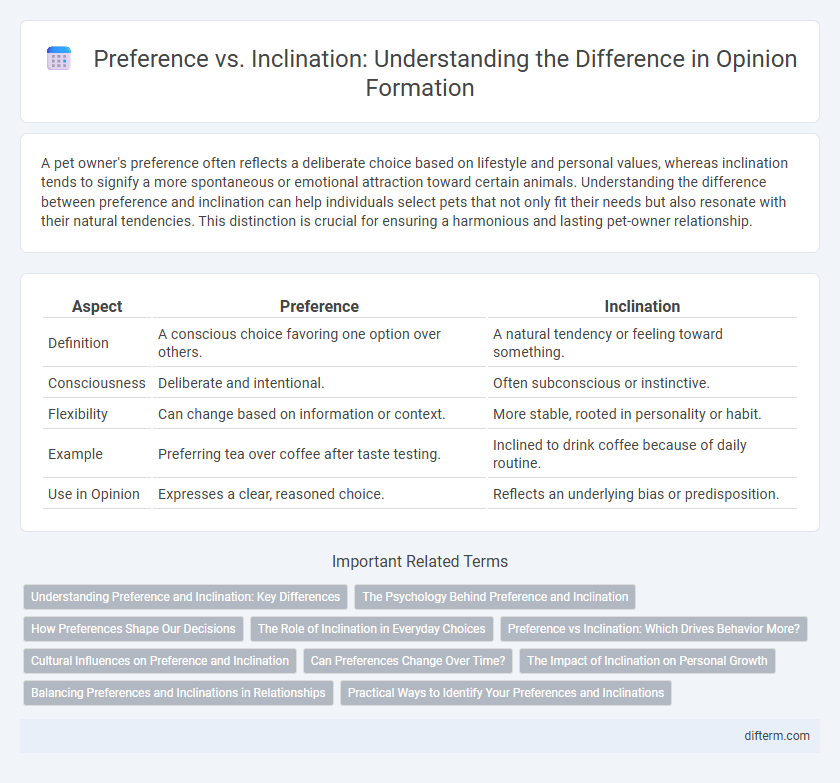A pet owner's preference often reflects a deliberate choice based on lifestyle and personal values, whereas inclination tends to signify a more spontaneous or emotional attraction toward certain animals. Understanding the difference between preference and inclination can help individuals select pets that not only fit their needs but also resonate with their natural tendencies. This distinction is crucial for ensuring a harmonious and lasting pet-owner relationship.
Table of Comparison
| Aspect | Preference | Inclination |
|---|---|---|
| Definition | A conscious choice favoring one option over others. | A natural tendency or feeling toward something. |
| Consciousness | Deliberate and intentional. | Often subconscious or instinctive. |
| Flexibility | Can change based on information or context. | More stable, rooted in personality or habit. |
| Example | Preferring tea over coffee after taste testing. | Inclined to drink coffee because of daily routine. |
| Use in Opinion | Expresses a clear, reasoned choice. | Reflects an underlying bias or predisposition. |
Understanding Preference and Inclination: Key Differences
Preference reflects a conscious choice for certain options based on values or desires, while inclination denotes a natural tendency or instinctive leaning toward something. Understanding the key differences between preference and inclination helps clarify how decisions are influenced either by deliberate consideration or by subconscious drives. This distinction is crucial in fields like psychology and marketing, where recognizing the basis of human behavior improves strategy and engagement.
The Psychology Behind Preference and Inclination
Preference reflects a conscious choice shaped by rational evaluation and past experiences, while inclination emerges from subconscious impulses and emotional responses. The psychology behind these concepts reveals that preferences are often stable and deliberate, guiding consistent decision-making, whereas inclinations fluctuate based on mood and context. Understanding the neural mechanisms, such as activation in the prefrontal cortex for preference and limbic system for inclination, provides insight into their distinct influences on behavior.
How Preferences Shape Our Decisions
Preferences shape our decisions by reflecting conscious choices rooted in values and experiences, guiding actions toward desired outcomes. Unlike inclinations, which are often subconscious and spontaneous, preferences involve deliberate evaluation and prioritization of options. This cognitive process reinforces decision-making patterns that align closely with individual goals and long-term satisfaction.
The Role of Inclination in Everyday Choices
Inclination plays a subtle yet powerful role in everyday choices by guiding decisions through personal biases and subconscious preferences. Unlike explicit preferences, inclinations often operate beneath conscious awareness, influencing actions such as selecting meals, leisure activities, or social interactions. Understanding and acknowledging these inclinations can lead to more mindful and authentic decision-making processes.
Preference vs Inclination: Which Drives Behavior More?
Preference often exerts a stronger influence on behavior than inclination due to its basis in deliberate choices shaped by values and past experiences. Inclination reflects a spontaneous or emotional tendency that may fluctuate, whereas preferences tend to be more stable and consciously acknowledged. Understanding the interplay between preference and inclination is crucial for predicting consistent behavioral patterns.
Cultural Influences on Preference and Inclination
Cultural influences shape preferences by embedding societal values and norms into individual choices, often guiding what is deemed desirable or acceptable. Inclinations, while also affected by culture, tend to emerge from deeper, perhaps subconscious, emotional responses influenced by early life experiences and communal traditions. Understanding the interplay between cultural context and personal tendencies reveals how both explicit preferences and subtle inclinations are continuously molded by the surrounding social environment.
Can Preferences Change Over Time?
Preferences often evolve due to new experiences, information, or changing circumstances, reflecting a dynamic rather than fixed nature. Unlike inclinations, which may arise from innate tendencies or deep-seated habits, preferences can shift as individuals reassess values and priorities. This adaptability highlights the fluid relationship between exposure and the conscious reassessment of what one favors.
The Impact of Inclination on Personal Growth
Inclination shapes personal growth by guiding individuals toward their genuine interests and strengths, fostering deeper engagement and sustained motivation. Unlike mere preference, inclination reflects an innate or subconscious pull that drives continuous learning and self-improvement. Recognizing and embracing these inclinations can accelerate development and lead to more fulfilling achievements.
Balancing Preferences and Inclinations in Relationships
Balancing preferences and inclinations in relationships requires understanding that preferences are often deliberate choices reflecting values, while inclinations stem from innate tendencies or emotions. Recognizing and respecting each partner's unique mix of both fosters empathy and strengthens communication. Emphasizing flexibility in preferences alongside honoring natural inclinations promotes harmony and mutual growth in long-term connections.
Practical Ways to Identify Your Preferences and Inclinations
Identifying your preferences involves analyzing consistent choices in hobbies, food, and social activities to uncover genuine likes. Observing your inclinations requires recognizing subtle, often subconscious, tendencies toward certain ideas or behaviors in daily situations. Keeping a reflective journal that tracks emotional responses to experiences enhances clarity between deliberate preferences and innate inclinations.
preference vs inclination Infographic

 difterm.com
difterm.com